Inca Art › Christiane Desroches Noblecourt » Ancient origins
Articles and Definitions › Contents
- Inca Art › Ancient History
- Christiane Desroches Noblecourt - Strong as the Stones she was able › Antique Origins
Ancient civilizations › Historical and archaeological sites
Inca Art › Ancient History
Definition and Origins
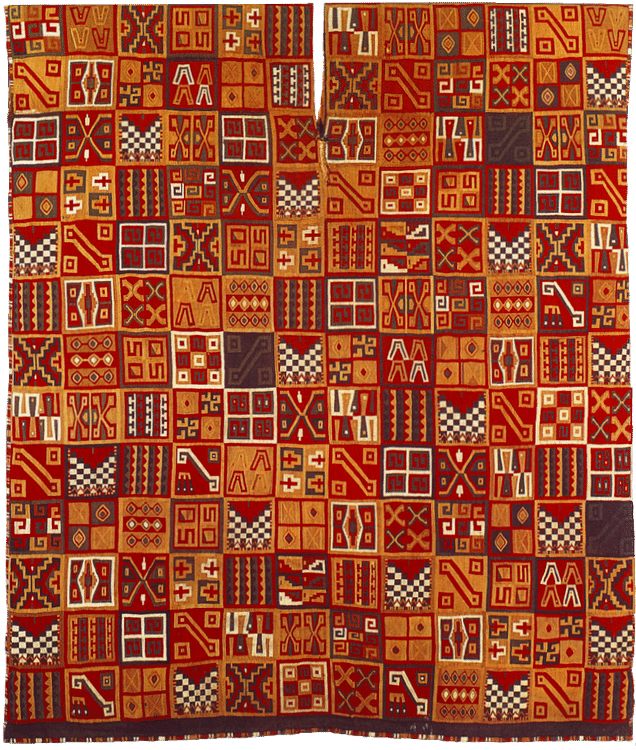
The art of the Inca civilization of Peru (c. 1425-1532 CE) produced some of the finest works ever crafted in the ancient Americas. Inca art is best seen in highly polished metalwork, ceramics, and, above all, textiles, with the last being considered the most prestigious by the Incas themselves. Designs often use geometrical shapes, are standardized, and technically accomplished. The European invaders destroyed much of Inca art either for sheer monetary gain or religious reasons but enough examples survive as testimony to the magnificent range and skills of Inca artists.
INFLUENCES & DESIGNS
Although influenced by the art and techniques of the earlier Chimu civilization, the Incas did create their own distinctive style which was an instantly recognisable symbol of imperial dominance across their massive empire. The Incas would go on to produce textiles, ceramics, and metal sculpture technically superior to any previous Andean culture, and this despite stiff competition from such masters of metalwork as the craftsmen of the Moche civilization.
Just as the Incas imposed a political dominance over their conquered subjects, so too with art, they imposed standard Inca forms and designs. The art itself did not suffer as a consequence, though. As art historian Rebecca Stone puts it,
Standardisation, though powerfully unifying, did not necessarily lower the quality of art; technically Inca tapestry, large-scale ceramic vessels, mortar-less masonry, and miniature metal sculptures are unsurpassed. ( Art of the Andes, 194)
The checkerboard stands out as a very popular design. One of the reasons for the repetition of designs was that pottery and textiles were often produced for the state as a tax, and so artworks were representative of specific communities and their cultural heritage. Just as today coins and stamps reflect a nation's history, so too, Andean artwork offered recognisable motifs which either represented the specific communities making them or the imposed designs of the ruling Inca class ordering them.The Incas did, though, allow local traditions to maintain their preferred colours and proportions. In addition, gifted artists such as those from Chan Chan or the Titicaca area and women particularly skilled at weaving were brought to Cuzco so that they could produce beautiful things for the Inca rulers.
ANDEAN ARTWORK OFFERED RECOGNISABLE MOTIFS WHICH REPRESENTED THE SPECIFIC COMMUNITIES MAKING THEM & THE IMPOSED DESIGNS OF THE RULING INCA CLASS ORDERING THEM.
It is also notable that both Inca pottery decoration and textiles did not include representations of themselves, their rituals, their military conquests, or such common Andean images as monsters and half-human, half-animal figures. Rather, the Incas almost always preferred colourful geometrical designs and abstract motifs representing animals and birds.
CERAMICS
Inca pottery used natural clay but added such materials as mica, sand, pulverised rock, and shell which prevented cracking during the firing process. There was no potter's wheel in the ancient Americas and so vessels were made by hand, first creating a base and then laying a coil of clay around it until the vessel reached the size required. Then the sides were smoothed using a flat stone. Smaller and medium-sized vessels were made using clay moulds. Before firing, a clay 'slip' was added and the vessel was painted, incised (sometimes using stamps), or had reliefs added. In kilns, pits, or open fires, the vessel was then fired using the oxidising method (adding oxygen to the flames) to create red, yellow and cream coloured pottery, or, via the reduction method (limiting the oxygen supply) to produce black wares.
Ceramics were for wider use, and so forms were, above all, practical. The most common shape was the urpu, a bulbous vessel used for storing maize with a long neck, flared lip, two small handles low on the pot, and a pointed base. The point at the base pressed into the ground and stabilised the pot while maize was poured into it. There were standardized sizes of urpubased on their content volume. They were decorated with abstract plant motifs and geometrical designs, most commonly zig-zags and dots. Examples from Cuzco are more elegant than those from other regions and are painted a distinctive black on red.

Inca Bird-handled Dish
Other types of ceramics are large flat serving dishes with animal figure handles, bowls, tall qeros beakers (made in pairs and also in wood), and the paccha. The latter was a hollow tube in the shape of a foot plough, typically decorated with three-dimensional additions such as a corn cob and urpu. The paccha (meaning 'waterfall') was placed into the ground so that maize beer could be ritually poured into it in ceremonies to promote a good harvest.
METALWORK
Objects using precious metals such as discs, jewellery, figurines, ceremonial knives ( tumi ), lime dippers, and everyday objects were made exclusively for Inca nobles. Gold was considered the sweat of the sun, and silver was considered the tears of the moon. Copper was another popular material, and these metals would have been inlaid with precious stones such as emeralds, polished semi-precious stones like lapis lazuli, polished bone, and spondylus shell. Alternatively, gold and silver were inlaid into bronze. Metals were alloyed, cast, beaten, incised, embossed, beaded, and used as gilding. Inca jewellery pieces made from precious metals included earrings, earspools, pendants, bracelets, and dress pins.
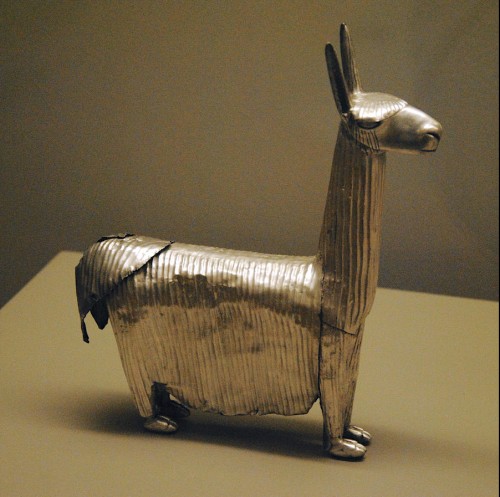
Inca Silver Alpaca
The Inca royalty only drank from gold and silver beakers, and their shoes had silver soles. Surviving figurines, both of humans and llamas, found in burial sites were made either by cast or with up to 18 separate sheets of gold and carved in intricate life-like detail. Gold and silver were also used for many religious pieces, especially representations of natural phenomena and places the Incas held sacred. These works represented the sun, moon, stars, rainbows, lightning, waterfalls, and so on. Masks representing the principal gods such as Inti the god of the sun and Mama Kilya the goddess of the moon, along with other sacred objects, were then placed within Inca temples but these have since been lost.
Perhaps the most famously lost Inca art piece is a gold statue of Inti, represented as a small seated boy and known as Punchao, which was kept in the Temple of the Sun, at the Coricancha ( Qorikancha ) sacred complex at Cuzco. With rays projecting from his head and decorated with gold jewellery, the stomach of this figure was used as a receptacle for the ashes of the burned vital organs of previous Inca kings. Each day the statue was brought outside of the temple to bask in the sun.Following the Spanish conquest the figure was removed and hidden, never to be found again.
The Coricancha also had a stunning garden dedicated to Inti. Everything in it was made of gold and silver. A large field of corn and life-size models of shepherds, llamas, jaguars, guinea pigs, monkeys, birds and even butterflies and insects were all crafted in precious metal. All that survives of these wonders are a few golden corn stalks, a convincing, if silent, testimony to the lost treasures of Inca metalworkers.
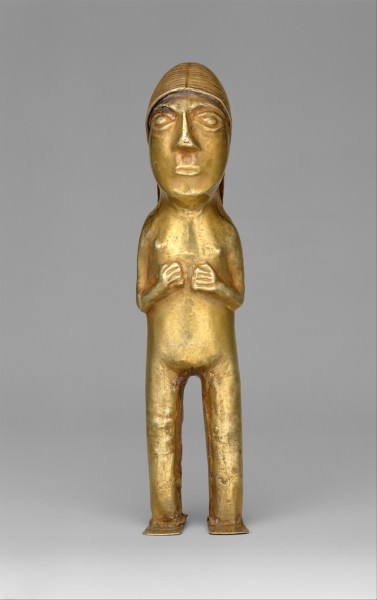
Inca Gold Female Figurine
TEXTILES
Although very few examples of Inca textiles survive from the heartland of the empire, we do have, thanks to the dryness of the Andean environment, many textile examples from the highlands and mountain burial sites. In addition, Spanish chroniclers often made drawings of textile designs and clothing so that we have a reasonable picture of the varieties in use. Consequently, we have many more examples of textiles than other crafts such as ceramics and metalwork.
For the Incas, finely worked and highly decorative textiles came to symbolize both wealth and status. Fine cloth could be used as both a tax and currency, and the very best textiles became amongst the most prized of all possessions, even more precious than gold or silver. Inca weavers were technically the most accomplished the Americas had ever seen and, with up to 120 wefts per centimetre, the best fabrics were considered the most precious gifts of all. As a result, when the Spanish arrived in the early 16th century CE, it was textiles and not metal goods which were given in welcome to these visitors from another world.
It seems that both men and women created textiles, but it was a skill women of all classes were expected to be accomplished at. At the capital Cuzco, the finest cloth was made by male specialists known as qumpicamayocs or 'keepers of the fine cloth'.The principal equipment was the backstrap loom for smaller pieces and either the horizontal single-heddle loom or vertical loom with four poles for larger pieces. Spinning was done with a drop spindle, typically in ceramic or wood. Inca textiles were made using cotton (especially on the coast and in the eastern lowlands) or llama, alpaca, and vicuña wool (more common in the highlands) which can be exceptionally fine. Goods made using the super-soft vicuña wool were restricted and only the Inca ruler could own vicuña herds. Rougher textiles were also made using maguey fibres.
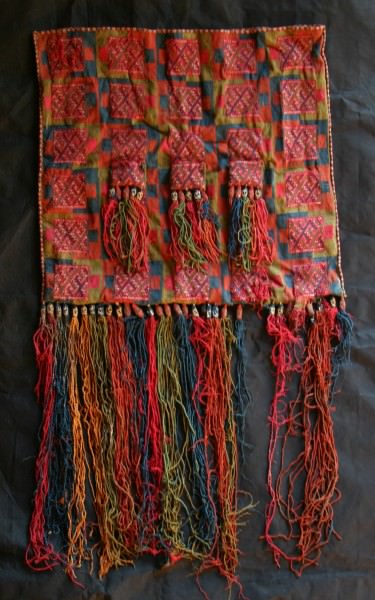
Inca Textile Bag
The principal colours used in Inca textiles were black, white, green, yellow, orange, purple, and red. These colours came from natural dyes which were extracted from plants, minerals, insects, and molluscs. Colours also had specific associations. For example, red was equated with conquest, rulership, and blood. This was most clearly seen in the Mascaypacha, the Inca state insignia, where each thread of its red tassel symbolised a conquered people. Green represented rainforests, the peoples who inhabited them, ancestors, rain and its consequent agricultural growth, coca, and tobacco. Black signified creation and death, while yellow could signal maize or gold. Purple was, as in the rainbow, considered the first colour and associated with Mama Oclla, the founding mother of the Inca race.
Besides using dyed strands to weave patterns, other techniques included embroidery, tapestry, mixing different layers of cloth, and painting – either by hand or using wooden stamps. The Incas favoured abstract geometric designs, especially checkerboard motifs, which repeated patterns ( tocapus ) across the surface of the cloth. Certain patterns may also have been ideograms. Non-geometrical subjects, often rendered in abstract form, included felines (especially jaguars and pumas), llamas, snakes, birds, sea creatures, and plants. Clothes were simply patterned, commonly with square designs at the waist and fringes and a triangle marking the neck. One such design was the standard military tunic which consisted of a black and white checkerboard design with an inverted red triangle at the neck.
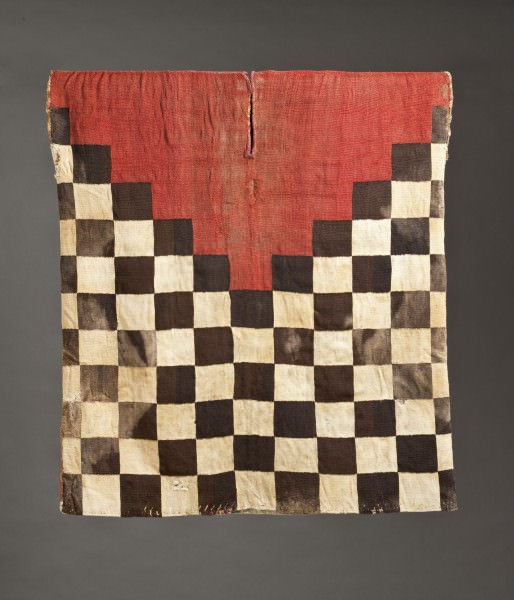
Inca Military Tunic
Additional decoration could be added to textile articles in the form of tassels, brocade, feathers, and beads of precious metal or shell. Precious metal threads could also be woven into the cloth itself. As feathers were usually from rare tropical birds and condors, these garments were reserved for the royal family and nobility.
CONCLUSION
The European invaders in the 16th century CE not only ruthlessly melted down or spirited away any precious Inca goods they found but also attempted to repress elements of Inca art, even banning such trivial objects as the qeros beakers in an attempt to curb drinking habits. Distinctive Inca textile designs such as those connected to royal power were also discouraged but, in defiance, many of the indigenous peoples continued with their artistic traditions. Thanks to this perseverance and continuity, and despite an evolution where designs were blended with elements of colonial art, many traditional Inca designs and motifs survive to this day and are celebrated as such in the ceramics, metalwork, and textiles of modern Peru.
Christiane Desroches Noblecourt - Strong as the Stones she was able › Antique Origins
Ancient Civilizations
Her name echoes down the corridors, in classrooms and in books, Christiane Desroches Noblecourt was a great French Egyptologist and, in the opinion of the writer, a woman strong and determined enough to have been the first female to direct an excavation in 1938 and afterwards, in 1960, possibly the most epic archaeological undertaking of all time.
Acting as an arbitrator during the Cold War, Christiane was able to bring together 50 countries for one purpose, was able to find the funding and bring together the best team to cope with the incredible and monumental rescue of Abu Simbel, operation that would cost more than $40 million dollars at the time.
To the south of Egypt on the border with Sudan, the area of Abu Simbel contains dozens of archaeological sites. In 1960 with the construction of the Aswan dam and its artificial water supply, these sites were in danger of being drowned and lost forever.
To the south of Egypt on the border with Sudan, the area of Abu Simbel contains dozens of archaeological sites. In 1960 with the construction of the Aswan dam and its artificial water supply, these sites were in danger of being drowned and lost forever.
The dam, built to control flooding of the Nile, is an extension of the previous basin which was not sufficiently large for the needs of the country. The new Great dam would create a reservoir (Lake Nasser) large enough to provide electricity to half of the country. This new lake, however, alarmed archaeologists who immediately realized the danger that the much-needed reservoir would create for archaeological sites, whose future would at best be one of complete obliteration.
CHRISTIANE WAS COMMISSIONED BY UNESCO TO TAKE A CENSUS OF ALL SITES AT RISK OF FLOODING.
All this did not happen because fortunately, Christiane's voice was heard, when doubts were raised over the dangers, Christiane was commissioned by UNESCO to take a census of all sites at risk of flooding, but she did not stop there, the number of endangered sites was too high, the importance of some of these led her to embark on a crusade, a race against the clock and all other obstacles to saving those sites.
She found financial backers and architects and smoothed the path to meetings with the archaeologists, but most especially she promoted the “ idea” of saving the endangered archaeological sites. The basin was ready and the dam project well under way. In journalism we often write about a “big project, “translation”, “bailout”, ”translocation”, or “relocation”, but in my opinion none of these words adequately describe the extent of the toil that was needed in order to save the temples, which were tens of meters high, carved into the rock, fragile and precious as the finest crystal. But between 1964 and 1968, the temples were completely cut into large blocks (weighing from 20 to 30 tons) dismantled, reassembled and raised to a new location 65 meters higher and 300 meters back from the river bank, with the labour of more than two thousand workers, led by a group of Italian quarrymen, experts in marble from Carrara, in an unprecedented technological effort. They faced one of the greatest challenges in the history of archaeological engineering.
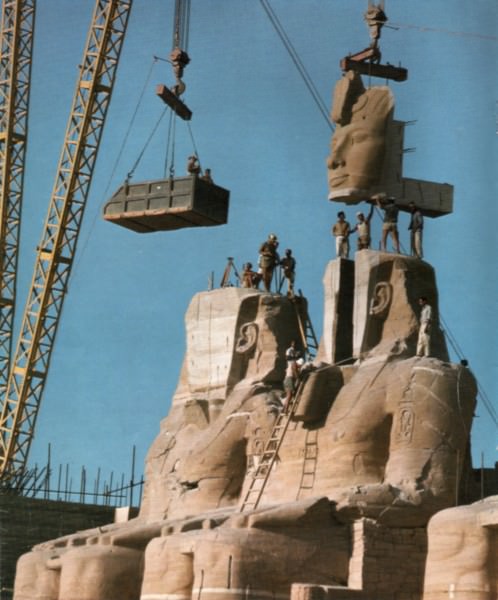
Abu Simbel - Work in Progess
And don't think that the decision to dissect the statues was easy to make. It was an anguished decision, deeply discussed and debated and there were probably quite a few archaeologists who wept over it. It might be said today that they could have done it differently, but for me it makes no difference, what mattered was: mission accomplished.
From the engineering point of view, the mode of transport was resolved, the new installation was defined with the domes of cement that would give shape to the hills on which the temples were to be supported, but the point to consider now is that of the archaeologists who in addition to checking that nothing was ruined by a little clumsy laboring, pledged to restore the balance between the original siting of the temples and the new installation.
From the engineering point of view, the mode of transport was resolved, the new installation was defined with the domes of cement that would give shape to the hills on which the temples were to be supported, but the point to consider now is that of the archaeologists who in addition to checking that nothing was ruined by a little clumsy laboring, pledged to restore the balance between the original siting of the temples and the new installation.
In this regard, the archaeologists made the decision to be consistent with that which they had to do, and chose not to consider transport as simply a fortuitous rescue to save only the material wealth of archaeological sites that were in danger, but they also made the commitment to “carry” the cult of the temple, to move it whilst honouring the fundamental reason why the temple was in that exact position in the first place.
I'm talking about the celestial phenomenon, which makes provision for the exact dates and precise times, when the sun's rays slant into the temple to illuminate the great room and the pharoah's stone effigies, gilded by the divine rays of the living Sun.
Built during the reign of Ramses II (1265 BCE), the great temple is the largest in the area and the largest to have been moved, and is dedicated to the gods Amun, Ra-Horakhty, Ptah and Ramses himself. To build it took twenty years of hard work not only in architecture alone.
Built during the reign of Ramses II (1265 BCE), the great temple is the largest in the area and the largest to have been moved, and is dedicated to the gods Amun, Ra-Horakhty, Ptah and Ramses himself. To build it took twenty years of hard work not only in architecture alone.
The architects of ancient Egypt aligned the temple so that, on October 21 and February 21 (61 days before and 61 days after the winter solstice), the sun's rays enter into the sanctuary to illuminate the sculptures on the wall, except for the statue of Ptah, the god associated with the underworld, which remains in shadow.
From studies done, but still very theoretical, the dates should match the king's birthday and coronation day, but there is no evidence to support this except the fact that if the sun is permitted to enter on those two particular dates it is for a significant purpose.
The light enters and illuminates the statues, the rays are directed primarily on the statue of Ramses. The power of the sun recharges and revitalizes him, beside him Amon Ra and Ra-Horakhty are also partially illuminated and Ptah is the god of darkness beside them perfectly in the shade.
The effort, in moving the temple, to be able to fully replicate the event, however, led to a margin of error of one day (forward) compared to the original dates, creating controversy and a regretful postscript to this otherwise so perfectly successful saga.But bearing in mind all the commitment shown by the people who contributed to the rescue, it should not be subjected to controversy but only relief and gratitude, as fate has decreed that the temples, though not yet a world heritage site, were later to become one at the completion of the work in their new location.

Ramesses II
One could almost hope that somewhere, Ramses II and his wife, Queen Nefertari, are nodding their heads in thoughtful approval, he of the saving of the temple, she of the strength and initiative of a member of her sex.
There are those born a few centuries ago, who would have liked to have lived at the time of the great Roman emperors, or in XVII century. I wish I had been born at the time of Christiane Desroches Noblecourt, an Egyptologist and an archaeologist who died in July of this year and is now being commemorated by archaeologists, scholars and by the great centers of archaeological studies as an advocate of one of the largest and most impressive archaeological works ever undertaken, the first woman in history to lead an excavation, curator of the Louvre, Christiane, who together with the Minister of Egyptian cultural heritage shared with the world what they were able to save, leaving to the museums of the world the images of Abu Simbel and its temples, telling the story of what they have done as a duty and not just as a part of a job.
There are those born a few centuries ago, who would have liked to have lived at the time of the great Roman emperors, or in XVII century. I wish I had been born at the time of Christiane Desroches Noblecourt, an Egyptologist and an archaeologist who died in July of this year and is now being commemorated by archaeologists, scholars and by the great centers of archaeological studies as an advocate of one of the largest and most impressive archaeological works ever undertaken, the first woman in history to lead an excavation, curator of the Louvre, Christiane, who together with the Minister of Egyptian cultural heritage shared with the world what they were able to save, leaving to the museums of the world the images of Abu Simbel and its temples, telling the story of what they have done as a duty and not just as a part of a job.
She led the people of France to launch an appeal to the reluctant and indifferent world, a plea for help, launched jointly with the then incumbent French Minister of Cultural Affairs, Andre Malraux: “The power that created the colossal monuments threatened today... speaks to us in a voice as exalted as that of the architects of Chartres, as that of Rembrandt...Your appeal is historic, not because it proposes to save the temples of Nubia, but because through it the first global civilizationpublicly claims the world's art as its indivisible heritage...There is only one action over which the indifference of stars and the eternal murmuring of rivers have no sway - it is the act by which man snatches something from death.”
She, who in front of the General Charles de Gaulle, was unimpressed when he at first did not understand what Christiane had set in motion and said: “Mais enfin, Madame, comment avez-vous osé dire que la France sauverait le temple, sans avoir été habilitée par mon gouvernement? ” and replied “Et comment, Général, avez-vous osé envoyer un appel à la radio, alors que vous n'aviez pas été habilité par Pétain? “.
I would have liked to be born at the time of Christiane Desroches Noblecourt and to have responded to her call for help.
LICENSE:
Article based on information obtained from these sources:with permission from the Website Ancient History Encyclopedia
Content is available under License Creative Commons: Attribution-NonCommercial-ShareAlike 3.0 Unported. CC-BY-NC-SA License